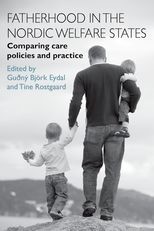 Fatherhood in the Nordic Welfare states: Comparing care policies and practice
Fatherhood in the Nordic Welfare states: Comparing care policies and practice
Contents
-
-
-
-
-
-
-
-
-
-
-
-
-
Introduction Introduction
-
Data and methods Data and methods
-
Finnish fathers’ leave options and take-up of leave Finnish fathers’ leave options and take-up of leave
-
Theoretical approach: everyday life connects policies, practices and change Theoretical approach: everyday life connects policies, practices and change
-
Everyday life, care work and gender Everyday life, care work and gender
-
-
Goals of Finnish parental leave policy: gender equality or ‘free choice’ Goals of Finnish parental leave policy: gender equality or ‘free choice’
-
The negotiation system and governance of leave policy The negotiation system and governance of leave policy
-
Gender equality and ‘free choice’ in the policy process: individual quotas or transferable leave Gender equality and ‘free choice’ in the policy process: individual quotas or transferable leave
-
Proposals of extended entitlements to fathers in 1999 Proposals of extended entitlements to fathers in 1999
-
Introduction of the Finnish father’s bonus leave in 2002 Introduction of the Finnish father’s bonus leave in 2002
-
Revisions of the scheme 2007–13 Revisions of the scheme 2007–13
-
-
Fathers’ individual motivations Fathers’ individual motivations
-
The role of the family economy The role of the family economy
-
Perceptions of the division of labour between women and men Perceptions of the division of labour between women and men
-
Pressures from work Pressures from work
-
-
Conclusion: ‘free choice’ and elusive gender equality Conclusion: ‘free choice’ and elusive gender equality
-
Notes Notes
-
References References
-
-
-
-
-
-
-
-
-
-
Fourteen Policy goals and obstacles for fathers’ parental leave in Finland
Get access-
Published:November 2014
Cite
Abstract
This chapter analyses why Finnish fathers do not take more parental leave even if promoting gender equality has been a longstanding goal of family policy. It shows that the obstacles are to be found not only in factors at the individual level but also in the structuring of leave schemes and in the special Finnish policy making process where the schemes are developed as compromises in tripartite negotiations between the central employer and employee organisations and the government. Based on a theory of how both continuity and change are produced in the interaction of structural conditions and the choices actors make in their everyday practices, the chapter argues that the policy process shapes the leave schemes and, thus guiding the choices, eventually also the take-up of leave and the slow improvement of gender equality.
Sign in
Personal account
- Sign in with email/username & password
- Get email alerts
- Save searches
- Purchase content
- Activate your purchase/trial code
- Add your ORCID iD
Purchase
Our books are available by subscription or purchase to libraries and institutions.
Purchasing information| Month: | Total Views: |
|---|---|
| November 2022 | 1 |
| November 2023 | 1 |
| December 2023 | 1 |
| January 2024 | 2 |
| March 2024 | 1 |
| April 2024 | 1 |
| December 2024 | 1 |
| January 2025 | 3 |



Get help with access
Institutional access
Access to content on Oxford Academic is often provided through institutional subscriptions and purchases. If you are a member of an institution with an active account, you may be able to access content in one of the following ways:
IP based access
Typically, access is provided across an institutional network to a range of IP addresses. This authentication occurs automatically, and it is not possible to sign out of an IP authenticated account.
Sign in through your institution
Choose this option to get remote access when outside your institution. Shibboleth/Open Athens technology is used to provide single sign-on between your institution’s website and Oxford Academic.
If your institution is not listed or you cannot sign in to your institution’s website, please contact your librarian or administrator.
Sign in with a library card
Enter your library card number to sign in. If you cannot sign in, please contact your librarian.
Society Members
Society member access to a journal is achieved in one of the following ways:
Sign in through society site
Many societies offer single sign-on between the society website and Oxford Academic. If you see ‘Sign in through society site’ in the sign in pane within a journal:
If you do not have a society account or have forgotten your username or password, please contact your society.
Sign in using a personal account
Some societies use Oxford Academic personal accounts to provide access to their members. See below.
Personal account
A personal account can be used to get email alerts, save searches, purchase content, and activate subscriptions.
Some societies use Oxford Academic personal accounts to provide access to their members.
Viewing your signed in accounts
Click the account icon in the top right to:
Signed in but can't access content
Oxford Academic is home to a wide variety of products. The institutional subscription may not cover the content that you are trying to access. If you believe you should have access to that content, please contact your librarian.
Institutional account management
For librarians and administrators, your personal account also provides access to institutional account management. Here you will find options to view and activate subscriptions, manage institutional settings and access options, access usage statistics, and more.